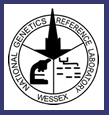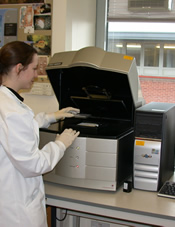
_
|
|
||||||||||||||||||||||||||||||
|
Evaluation
of PSQ 96MA System from Pyrosequencing™
|
|||||||||||||||||||||||||||||||
| Project
Leader: Dr Helen White
Company Website: www.biotage.com Pyrosequencing™ technology is a real time sequencing method for the analysis of short to medium length DNA sequences. Four enzymes and specific substrates are used to produce light whenever a nucleotide forms a base pair with the complementary base in a DNA template strand. Biotinylated PCR products are converted to single stranded templates onto which a sequencing primer is annealed. Analysis begins as the enzymes and substrates are dispensed into the reaction, nucleotides are dispensed sequentially and a light signal is detected and the base registered. If the added nucleotide is not complementary to the next base in the template then no light is generated. Genotypes can be determined and quantified using the PSQ™ 96MA System and the Allele Frequency Quantification function of the SNP software. The following assays are currently being developed and evaluated at NGRL (Wessex) click on relevant links to see more details: 1) Detection of Factor V Leiden (G1691A), Factor II (G20210A ) & MTHFR (C677T) 90 anonymised DNA samples that had been previously genotyped using
restriction enzyme digestion were re-tested using a multiplex Pyrosequencing
assay (in collaboration with Dr L Lavender, Molecular Pathology
Unit, Southampton). 2) Detection of mitochondrial mutations and estimation of mutation load 50 anonymised DNA samples were analysed using assays designed by NGRL (Wessex) for G3460A (LHON), G11778A (LHON), T14484C (LHON), A3243G (MELAS), A8344G (MERRF) & T8993G (NARP/Leighs). The DNA samples had been genotyped previously and the level of heteroplasmy had been estimated using (fluorescent) PCR and restriction digestion (in collaboration with Dr A Seller, Oxford Medical Genetics Laboratory) White HE, Durston VJ, Seller A, Fratter C, Harvey JF, Cross NCP. Accurate detection and quantitation of heteroplasmic mitochondrial point mutations by Pyrosequencing. Genetic Testing. 2005;9:190-9 9 Technology Assessment Report White HE, Durston VJ, Harvey JF, Cross NCP. Quantitative analysis of SNRPN gene methylation by Pyrosequencing as a diagnostic test for Prader Willi Syndrome and Angelman Syndrome. Clin Chem. March 2006; doi:10.1373/clinchem.2005.065086 Technology Assessment Report We have been collaborating with Prof Antonarakis at the University of Geneva to evaluate assays that detect aneuploidy by paralogous gene quantification 1. Sequence similarites are exploited to co-amplify paralogue sequences located on different chromosomes. Single nucleotide differences between the paralogue sequences are then quantified using Pyrosequencing technology and the ratio of the SNPs reflects the relatively frequency of the chromosomes tested. We have been evaluating the assay for detection of trisomy 21 and have found the method to be reliable and robust. Assays for trisomy 13 and 18 were, however, more problematic and we have been unable to perform reliable and robust assays for chromosomes 13 and 18. A paper discussing our findings is currently in preparation. 1Samuel Deutsch, Urmila Choudhury, Giuseppe Merla, Cedric Howald, Anna Sylvan, Stylianos E Antonarakis (2004) Detection of aneuploidies by Paralogous Sequence Quantification. J Med Genet; 41:908-915 |
|||||||||||||||||||||||||||||||
Last Updated: 7 August, 2008 by G. Watkins |
|||||||||||||||||||||||||||||||
